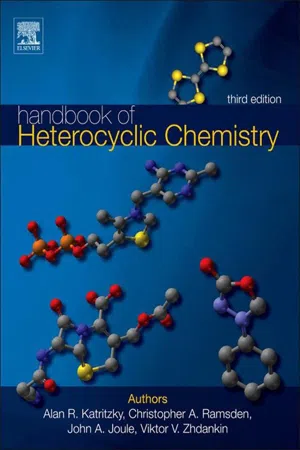
Palladium in Heterocyclic Chemistry
A Guide for the Synthetic Chemist
- 658 pages
- English
- ePUB (mobile friendly)
- Available on iOS & Android
About This Book
Palladium chemistry, despite its immaturity, has rapidly become an indispensable tool for synthetic organic chemists. Heterocycles are of paramount importance in the pharmaceutical industry and palladium chemistry is one of the most novel and efficient ways of making heterocycles. Today, palladium-catalyzed coupling is the method of choice for the synthesis of a wide range of biaryls and heterobiaryls. The number of applications of palladium chemistry to the syntheses of heterocycles has grown exponentially.
These developments highlight the need for a monograph dedicated solely to the palladium chemistry in heterocycles and this book provides a comprehensive explanation of the subject. The principal aim of Palladium in Heterocyclic Chemistry is to highlight important palladium-mediated reactions of heterocycles with emphasis on the unique characteristics of individual heterocycles.
1. Palladium chemistry of heterocycles has its "idiosyncrasies" stemming from their different structural properties from the corresponding carbocyclic aryl compounds. Even activated chloroheterocycles are sufficiently reactive to undergo Pd-catalyzed reactions. As a consequence of &agr and &bgr activation of heteroaryl halides, Pd-catalyzed chemistry may take place regioselectively at the activated positions, a phenomenon rarely seen in carbocyclic aryl halides. In addition, another salient peculiarity in palladium chemistry of heterocycles is the so-called "heteroaryl Heck reaction". For instance, while intermolecular palladium-catalyzed arylations of carbocyclic arenes are rare, palladium-catalyzed arylations of azoles and many other heterocycles readily take place. Therefore, the principal aim of this book is to highlight important palladium-mediated reactions of heterocycles with emphasis on the unique characteristics of individual heterocycles.
2. A myriad of heterocycles are biologically active and therefore of paramount importance to medicinal and agricultural chemists. Many heterocycle-containing natural products (they are highlighted in boxes throughout the text) have elicited great interest from both academic and industrial research groups. Recognizing the similarities between the palladium chemistry of arenes and heteroarenes, a critical survey of the accomplishments in heterocyclic chemistry will keep readers abreast of such a fast-growing field. We also hope this book will spur more interest and inspire ideas in such an extremely useful area.
This book comprises a compilation of important preparations of heteroaryl halides, boranes and stannanes for each heterocycle. The large body of data regarding palladium-mediated polymerization of heterocycles in material chemistry is not focused here; neither is coordination chemistry involving palladium and heterocycles.
Many heterocycle-containing natural products (highlighted throughout the text) have elicited great interest from both academic and industrial research groups. Recognizing the similarities between the palladium chemistry of arenes and heteroarenes, a critical survey of the accomplishments in heterocyclic chemistry keeps readers abreast of this fast-growing field. It is also hoped that this book will stimulate more interest and inspire new ideas in this exciting field.
- Contains the most up-to-date developments in this fast-moving field
- Includes 3 new chapters
- Contains material from selected well-respected authors on heterocyclic chemistry
Frequently asked questions
Information
An introduction to palladium catalysis









1.1 Oxidative coupling/cyclization
Table of contents
- Cover image
- Title page
- Table of Contents
- Copyright page
- Contributing authors
- Preface to the first edition
- Preface to the second edition
- Abbreviations
- Chapter 1: An introduction to palladium catalysis
- Chapter 2: Pyrroles
- Chapter 3: Indoles
- Chapter 4: Pyridines
- Chapter 5: Thiophenes and benzo[b]thiophenes
- Chapter 6: Furans and benzo[b]furans
- Chapter 7: Thiazoles and benzothiazoles
- Chapter 8: Oxazoles and benzoxazoles
- Chapter 9: Imidazoles
- Chapter 10: Pyrazines and quinoxalines
- Chapter 11: Pyrimidines
- Chapter 12: Quinolines
- Chapter 13: Pyridazines
- Chapter 14: Industrial scale palladium chemistry
- Index